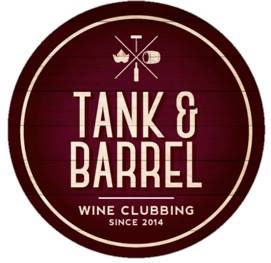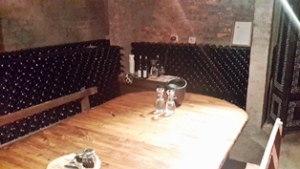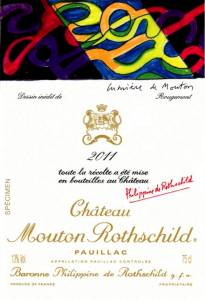The post [Frank the Tank] – Some sweet thoughts on Botrytis appeared first on Incogvino.
]]>
Wine Club for Cool Kids
Frank the Tank provides the monthly wine tips that accompany Tank & Barrel shipments. Frank’s thoughts on wine intrigue, illuminate and interest readers and tie into the monthly offering in your Tank & Barrel delivery. In September, Tank & Barrel shipped Bloemendal wines – two distinct wines made from the same grapes in the same block – one being a straight dry Semillon and the other a Noble Late Harvest of the same grapes. This offering serves as a tangible demonstration on how winemakers can achieve variety through different techniques and styles. For more information about Tank & Barrel or to join and have two brilliantly interesting wines shipped to your door monthly, check out their Facebook page or website to sign up. Below are Frank’s thoughts on Botrytis – the Dr. Jekyll and Mr. Hyde of fungus.
Ahhhh sweet wines! The domain of the old, the uninformed and the English.
Not so fast, mister! If you get the chance to taste wines, made with the intent to be proper sweet wines, as opposed to the sweetened up go-go juice that lines our supermarket’s shelves; you will realize there is something truly special afoot. A quick note at this stage – we all “talk dry” but our palates are wired to like sweet, it’s Darwinian – look at bees, babies and bears alike: we are all attracted by sweetness and if we are honest, sweet and semi-sweet plonk has introduced more than one of us to the world of wine and is the entry point for many many people around the world. But it’s also too much fun to knock it, so we can’t resist.
Obviously there are a multitude of sweeties out there: Port, Madeira, VDN’s, Noble Late Harvest, Special Late Harvests, Straw Wines, Raison Wines, etc etc… Today we turn our attention to the fanciest of them all: the Noble Late.
A NLH is more than a raisin where pure dehydration has caused an increase in the sugar concentration. Indeed, something far more special occurs here. When the perfect climatic conditions occur, grapes become susceptible to a special fungus: Botrytis cinerea. Throw in misty mornings and warm afternoons and you have the mix you need for this deliciousness-causing fuzz to start growing.
Botrytis goes to work on the grapes by penetrating their skins – this puncturing itself causes a dehydration effect, which is part one of achieving the sweetness.
But Botrytis also forms a few additional chemical compounds during its sojourn on the grapes; these compounds are the reason why Sauternes will differ fundamentally from a wine such as Vin de Constance (which is made from dehydrated grapes, not botrytized).
If you don’t know what you’re looking for, you might get a fright as these grapes are the least attractive looking grapes you’ve ever seen; they are shriveled up, hairy (literally hairy, due to the botrytis growth) and look like rotting fruit. But the juice they produce is the nectar of the gods – thick, unctuous, sweet to the hilt but with a bracing acidity (acidity levels actually increases due to the Botrytis activity). It takes hours of patient pressing to recover the previous juice. “Recovery” (i.e. yield in juice terms) is in the region of 200 liters per ton; about 3.5 times less than you’d get from normal, non-Botrytis grapes.
Most botrytised wines are matured and aged in barrel, as the juice is naturally quite robust and needs a counterpart to balance its intensity; French oak fits the bill very neatly.
Does this happen year after year? No. Not even in areas renowned for their Botrytized wines such as Sauternes or the Loire Valley. I (Francois) have seen actual proper botrytis on South African grapes all of three times in 15 years, and only once was there enough to justify picking, sorting and turning it into wine, and thus was born the 2013 Bloemendal Noble Late Harvest Semillon. And the rest, as they say, is history.
The post [Frank the Tank] – Some sweet thoughts on Botrytis appeared first on Incogvino.
]]>The post A Visit to Lithos {Guest Post} appeared first on Incogvino.
]]>
Lithos Cellar
After one of our most interactive and exciting Twitter tastings with Lithos wines, one of our SuperFANS, Stephen Brierley, went along to the farm to discover where the magic is made. If you want to follow Stephen on Twitter for his magnificent tweets about wine, you can find him at @sbrierley75. If you’d like to visit Lithos, contact them at @wines_lithos or visit their website.
I had a long overdue engagement with Tim Hoek, the winemaker from Lithos wines and just under two hours in traffic from Century City to Somerset West was not going to stop me. The farm is on Old Sir Lowrys Pass Road, on Wedderwill Country Estate. The Estate has another wine farm on its property, but that is a topic for another post. Lithos wine farm is situated between the Schapenberg mountain range to the east, the vistas of False Bay, that go on and on all the way to Cape point, to the west.
Lithos is owned by Sean and Lorraine. Sean is a financier, who still spends time travelling around the country on business, while Lorraine is an artist and a dreamer and conceptualised the name of the farm. Lithos comes from the word Lithosphere which is the outermost shell of our planet. The terroir in the area is excellent, previously being submerged beneath the waves of the Agulhas and now comprises of a top layer of sandy loam, with clay beneath which requires very little or no irrigation during summer months. The vines were planted in 2003 by the previous owners, who made wine for their own consumption, and the farm was bought and developed by Sean and Lorraine in 2011.
Tim Hoek found his way as winemaker to the farm from Jordan, where he was the assistant winemaker for five years. Tim and his wife, also a winemaker, have spent time in Bordeaux, Napa, New Zealand and have also made sparkling wine in the UK. Tim was born in Swellendam and obtained his agricultural degree in Wellington.
Tim’s manner is cool, calm and collected. He had previous aspirations to make beer, if the wine industry turned out not to be for him. But fate dealt him good hand and he now produces both wine and beer for the farm. An unusual occurrence; a wine farm that produces beer, but as Lorraine states: “We make and sell beer during the off season when we are not focused solely on the wines”. Nothing wrong with a dual income, I say! The beer is bottled under the Lithos labels: a haunting set of winged designs which were conceptualised by Lorraine, but designed by Vim Botha.
The beer is an interesting offering and ranges from 3.5% to 5% in alcohol. The lightest is a Raspberry Weiss which Lorraine thinks should be aimed at the female market. It is clean and refreshing with the obvious hint of rasberries, which is by no means sweet and overpowering. Sunset Ale is their pale ale, which is snappish and has slightly more a finish to it than the previous. The Midnight Stout is sharp and bitter and was my favourite. I took a carry bag of this home with me. All the beers are fairly light and would go down well with a range of food dishes.
After the beer tasting (apt for recovering from a Friday spent in too traffic), we moved onto their wines. They offer a range of 3 wines. The first was a Blanc De Noir, made with Pinotage, Shiraz and Cabernet Sauvignon. It offers a strawberry fruit jam nose, light acidity and a layered freshness which was drier in terms of sugar content than a more typical rosé, but presents a good balanced between the three cultivars. This wine would go very well with a cream based pasta, or even a big hunk of salmon where the acidity would cut through the fat and oil.
Their Cape Blend, of which a limited quantity is available as they produced only 2100 bottles, is clean and balanced with Cabernet Sauvignon, Shiraz, Pinotage and Cabernet Franc grapes. The wine is fermented in 2nd, 3rd and 4th fill barrels, so it only had a hint of tannins and wood to it.
Their last wine on offer was the Syrah, which they referred to us such rather than a Shiraz as it was grown in the cooler climate of the area, which is generally 2-3 degrees colder than Stellenbosch. The wine gave me a wonderful delivery of plums on the nose, slightly moist biltong too and the mouth delivered a subtle smack of white pepper. It is a wine that is light on the palate with 40% matured in new oak.
Tim has recently produced a Cabernet Sauvignon with grapes bought in from Stellenbosch, which he matured in barrels for 28 months. He is not ready to release this yet, but the excitement of this new addition was evident.
I only managed to catch a glimpse of the landscape views on arriving at the Estate, but what I did see was breathtaking and worth a visit earlier in the day. Lorraine is an aspiring cook and offers food and wine evenings, where clients can sample the beer and wine with a hearty meal alongside. I could have spent more time with the family but sadly after 90 minutes I had to drag myself out and home, just catching glimpses of the most impressive scenery below before the sun disappeared from sight.
The farm is well worth the visit and is along the same road as other impressive estates in Journeys End and Waterkloof. The wines are available from Wine Concepts and Vino Pronto, but I would suggest a visit to the farm for the sights, sounds and warmth of Lithos wines.
The post A Visit to Lithos {Guest Post} appeared first on Incogvino.
]]>The post Alcohol advertising from a wine label’s perspective {Guest Post} appeared first on Incogvino.
]]>The colourful serpentine lines of the French painter and sculptor, Guy de Rougemont, has become the latest commissioned artwork to adorn the label of Chȃteau Mouton Rothschild’s 2011 Pauillac first growth.
Philippe de Rothschild has been ambitiously marketing his wines by enlisting important artists to create original designs for his wine labels, to enhance the marketing ability of his wines, since the 1920’s. Some of the well known artists include Andy Warhol, Pablo Picasso, Salvador Dali, Georges Braque, Francis Bacon, Juan Miró and Lucien Freud. This was of such importance and value to him that he brought out a completely blank label in 1993 in protest against the USA’s refusal to distribute his wines sporting the artwork by French painter, Balthus Klossowski, consisting of a line drawing of a nude woman. And as confirmation of the advertising power of this “mobile billboard” better known as the wine label, this curious situation caught the attention of wine consumers and collectors globally, resulting in enormous profits for Mouton Rothschild. (However, a rock solid history of exceptional wines obviously also helps.)
But, notwithstanding the marketing value of any wine label, it also primarily distinguishes a winemaker’s products from the products of other producers and competitors. Because the character and quality of a wine are not only determined by its varietal, but also directly by the climate, soil and location (terroir) it grows in and viticulture practices of the farmer, it is of utter importance that the origin of the grapes is indicated on the wine label to enable the consumer to make a befitting choice or to ensure that the consumer locates the correct or desired wine. In South Africa such an origin control system has been in place for years. Only if 100% of the grapes, from which the wine was made, come from the same demarcated area, may the label use the abbreviation W.O. or Wine of Origin, followed by the name of the specific production area such as Stellenbosch or Robertson.
Wine labels also serve as visual communicators, educating consumers regarding the wine’s history and heritage such as the quirky Boer & Brit labels designed by the Fanakalo team, Jan Solms and Rohan Etsebeth.
In a 2011 study, conducted by Wine Intelligence, they found that a wine label is one of the most powerful ways to influence consumer perceptions of a wine. It is almost as if the beauty of the label, serving as the final finesse on any bottle, reflects the divinity of the wine inside the bottle. During a two-day forum held in Amsterdam, discussing so called “neuro marketing”, they further found that consumers of luxury goods, such as wine, are particularly influenced by pleasant colour combinations, thoughtful designs touches and a clear brand image recommending that producers and retailers, dealing with such goods, need to envelop the consumer in a complete sensory experience of the brand. An experience completely suited to the needs of a typical wine consumer, considering the importance aspects such as aroma, taste and ambience of a tasting room have on their decision to buy a wine, which experience can ultimately be summed up or revisited on the wine’s label.
The ban on alcohol advertising, proposed by the recently approved Control of Marketing of Alcoholic Beverages Bill, as well as the ominous threat of possible plain packaging regulations, similar to those contained in Australia’s Tobacco Plain Packaging Act 148 of 2011, from a wine label’s perspective, is clearly of great concern. Although very little is known about the details contained in the said Bill, it is foreseen that the culmination of the aforementioned will seriously restrict a wine consumers’ freedom of choice and also prohibit them from distinguishing wines from various demarcated regions, ultimately preventing consumers from choosing their wine of preference form a desired region. This will also leave wine producers in the dark, as wine consumers’ choices will no longer be able to guide them in consumers’ preferences and leave producers unable to profitably cater for consumers’ demands. Unable to choose a wine for its finely crafted content, consumers might fall into a habit of bargain driven buying which will have a tremendous negative financial effect on an industry already under severe economic pressure which might lead to even more exports, depriving locals of one of our country’s best home grown and produced products.
Health Minister Aaron Motsoaledi, motivates the Control of Marketing of Alcoholic Beverages Bill by saying that alcohol has been found to be a major contributing factor in the majority of motor vehicle accidents and that it has also been linked to crime and violence in South Africa. Subsequently he feels himself obliged to protect the consumers of alcohol from their self inflicted bad habits by creating a “nanny state” in which the consumer’s freedom of choice is regulated to the point of extinction. Deputy Health Minister Gwen Ramokgopa wants to extend this protection by revising the regulations for labelling of alcoholic beverages to include health warnings. Considering the ministers’ stance against alcohol and tobacco products, and the parallels often drawn between these types of products, in view of the global developments in respect of plain packaging regulations for tobacco products, it might only be a question of time before similar regulations might be imposed on packaging of alcohol products, which includes wine labels. Having touched on the parallels between alcohol and tobacco, it must be stressed that the most effective anti-smoking initiatives have been multi faceted. Similarly, the problems with alcohol abuse are complex and often alcohol abuse is a mere symptom of a much larger socio-economic illness.
In a British study evaluating the impact of picture health warnings on cigarette packets the researchers concluded that:
“There were few changes post implementation of the picture health warnings in the number of health effects recalled or participant’s perception of risk…There were no differences post implementation of the picture health warnings in the number of smokers reporting forgoing a cigarette when about to smoke one or stubbing our a cigarette because they thought about the health risk of smoking…Among young people, the impact of picture health warnings was negligible.”
Considering the mentioned “neuro marketing” element in advertising of luxury goods, such as wine, it seems that the banning of any advertising in respect of these goods might only have an effect on the educated consumer who is looking for a specific product, while such banning might have no effect at all on the bargain driven consumer, who (it seems) is also the consumer most likely to overindulge.
In principle it is unfair to judge cigarettes and wine on the same basis. Cigarettes are the only products, if used as intended by the manufacturer, that are likely to kill you, whilst wine have a wide range of proven health benefits if used moderately.
It is absurd to think that people can be legislated into responsibly consuming alcoholic beverages. Notwithstanding the State’s good intentions, it can never replace a parent’s role in educating a person into responsibility. The negative impact such legislation will have on the liquor industry, its economy, sponsorships for sport events, intellectual property rights and employment far outweighs the remote possibility it might have in combating motor vehicle accidents, criminal activity and domestic violence on its own. A balance must be struck between state protection and a consumer’s right to sovereign choice.
In context of a wine label, the intended legislation put so much more at risk than the mere advertising of an alcoholic beverage. Blind legislation in this regard might also deprive us of the valuable trademarks, proud heritage, rich history, unique terroir, colourful stories and precious art depicted on and represented by wine labels.
The post Alcohol advertising from a wine label’s perspective {Guest Post} appeared first on Incogvino.
]]>